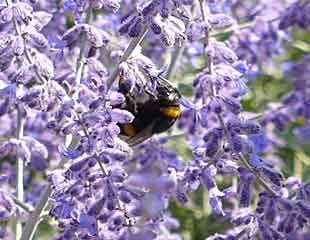
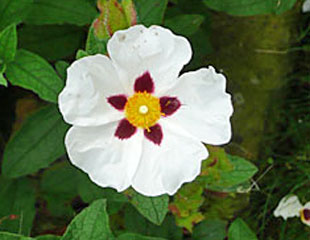
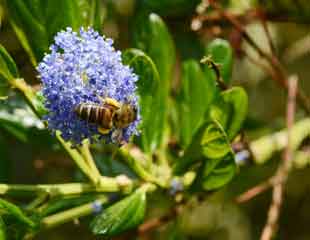
The 20 Best Drought resistant Plants and Shrubs
Our climate is now more prone to periods of drought during both early spring and summer. This can mean that dry areas of the garden are becoming drier, or that some areas need constant watering which is not sustainable in the long term. Many gardens need plants which are adapted to drought and which will survive with no or minimal watering.
The plants and shrubs listed here are more drought tolerant varieties which will thrive in dry soils. Watering cannot be eliminated completely, but many will survive weeks of dry weather before becoming fatigued.
When should you water?
Watering can become essential if the plant shows signs of stress. This is demonstrated by withering leaves, wilting, leaf drop, browning and the plant looks tired. When this happens, water to the roots and if the hot sunny weather is continuing, watering in the morning or evening when it is cooler which reduces water evaporation. Early in the season, lay a mulch over the border to help retain moisture.
Drought-resistant plants and shrubs are amongst some of the most colourful and attractive garden plants, and there are lots to choose from. There are so many lovely plants illustrated below, having a dry border is definitely an asset to any garden. It is also a benefit to bees, as many of the plants below are visited by bees and pollinators.
Tips on Gardening for Drought conditions
In 2022, during our severe drought, the RHS did a survey to find out which plants suffered the most in the heatwave. This is really helpful to look at and compare with your own garden.
Crocus has some lovely ideas on drought resistant planting combinations.( affiliate link)
Stachys Byzantina
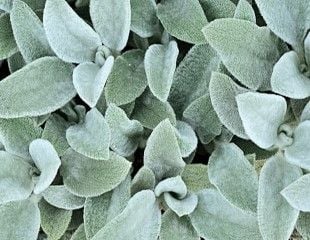
A lovely silver ground cover plant which has soft downy leaves. It has spikes of purple flowers which appear small, and insignificant, but are much loved by bees including the wool carder bee. Hardy H7, ideal to grow in dry soils in full sun. Common name lambs ears. More info.
Erigeron karvinskianus
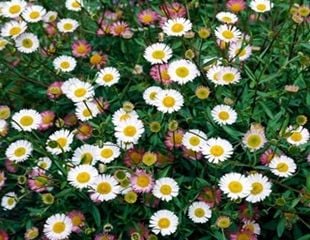
This a herbaceous perennial, long flowering from late spring throughout summer and has daisy type flowers. It is low growing, reaching a maximum of .5m. It is a self seeder, hardy H5, and its common name is Mexican Fleabane. Growing tips.
Lavender
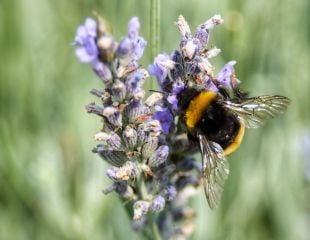
Lavender, a popular garden favourite, will not only thrive on dry soil, it positively hates wet soil in which it performs poorly. There is an enormous range of lavenders to choose from in size, colour and hardiness. More images and growing tips.
Wisteria
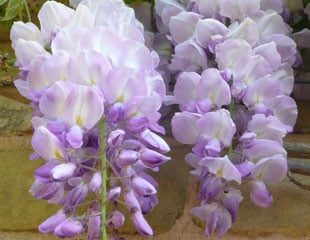
One of the most spectacular garden climbing plants, Wisteria will grow in dry conditions. It tolerates partial shade, but flowers best in sun. It is fully hardy H7 and there are many shades of blue, mauve and white to choose from. Lots of growing advice and videos.
Sedum
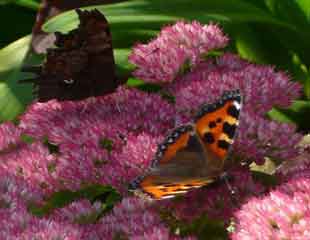
Sedum love a dry sunny spot and are a magnet for bees, pollinators of all types, and butterflies, they often visit the flowers even before they are fully open. Sedum range from low growing ground cover to tall varieties reaching 1m. Most are fully hardy and as perennials retain their shape over winter. Growing tips.
Santolina
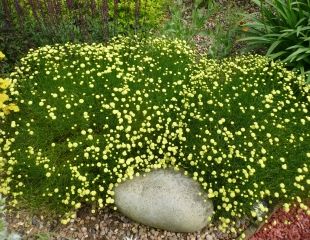
A low-growing shrub which thrives in dry sunny spots, Santolina looks attractive as illustrated here, planted around a stone. It has aromatic leaves, reaches about .5m, evergreen and summer flowering. Its common name is cotton lavender, and it is hardy to H5.
Perovskia

Perovskia is classed as a sub shrub, somewhere between a plant and a shrub. It is a woody plant with aromatic leaves, a bee magnet which grows to around 1.2-1.5m, tolerant of dry, poor soils and best grown in full sun. Fully hardy, late flowering throughout August and September, its common name is Russian Sage.
Silver leaved plants
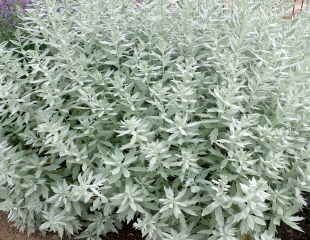
Most grey and silver leaved plants cope well with dry conditions and look good planted together - silver planting ideas, tips and planting advice. Illustrated here is a particularly nice form of Artemisa ' Valarie Finnis'. Many of the silver-leaved plants are Mediterranean in origin and accommodate dry conditions easily.
Ceanothus
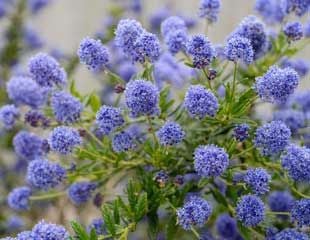
The common name of Ceanothus is Californian lilac, so it's hardly surprising that it grows well in dry conditions. This shrub will grow up to 2.5m, and whilst described as hardy it needs a sheltered spot away from chilly winds. In the right spot it makes a spectacular shrub. Growing tips and advice.
Lavatera
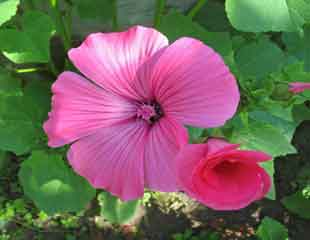
Lavatera grow up to around 2m with an abundance of lovely pink flowers throughout the summer which resemble hollyhocks. Lavatera are mostly described as hardy H5, but still require to be planted in a sheltered spot and are relatively short-lived shrubs. An easy to grow deciduous shrub. Images and growing tips.
Cistus
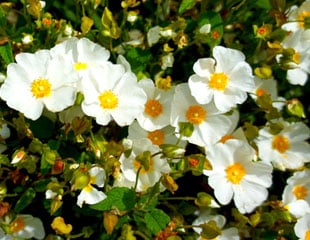
Cistus clearly likes dry sunny conditions, its common name is Rock or Sun Rose. It is a medium-sized shrub growing up to 1.5m. Whilst it is evergreen, it may lose some leaves over winter. It is summer flowering in shades of white, cream and soft pink and only H3/4 hardy, but the drier the conditions the more like it is to survive the winter. more info.
Achillea
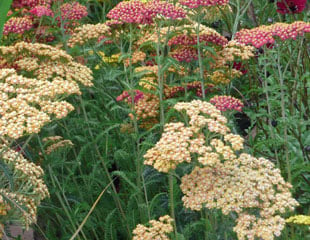
Achillea will grow in full sun or partial shade. It is a herbaceous summer flowering perennial. An ideal border plant because of the wide range of flower colours ranging from muted shades as illustrated, but also bright cerise, terracotta, yellow, red; much to choose from making it an easy fit for a dry border. Images of the different colours and growing advice.
Agapanthus
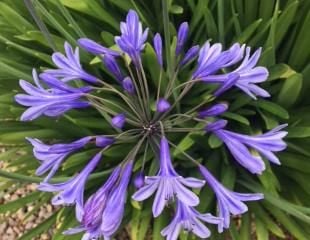
Agapanthus will tolerate dry conditions, especially so once established. There are both evergreen and herbaceous varieties and not all are fully hardy and may need winter protection. Given that in some areas they may need to be brought under cover, Agapanthus are ideal for growing in containers where the tendency to dry conditions will suit them. Tips and planting advice.
Eryngium
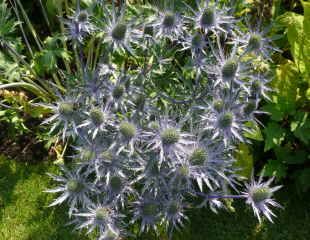
The common name is Sea Holly which makes sense given that the plant has thistle like flowers and is tolerant of salty conditions in coastal gardens. It flowers in shades of blue or white, easy to grow and low maintenance, with a range in heights from short .5m to 1.5m. Mostly varieties are hardy to H5 and are best planted in a sheltered spot in full sun.
Echinops

A similar plant is Echinops, with silver blue foliage and globes of blue flowers which are loved by bees. It is very hardy, H7 and will grow well in both sun and partial shade, as long as the soil is well drained. Illustrated above it looks lovely combined with Monarda, and Stipa gigantea making for a colourful late summer display.(credit image RHS Harlow Carr Jason Ingram)
Stipa
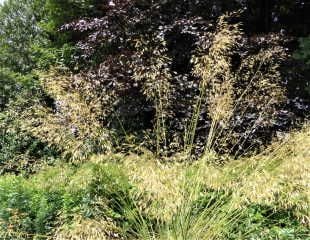
Following on from the last selection of dry soil plants, is the grass Stipa gigantea with tall airy plumes of oat grass towering up to 2m it can look very dramatic in borders. There are other grasses tolerant of dry conditions such as Pennisetum, Miscanthus and blue grasses.
Pelargonium
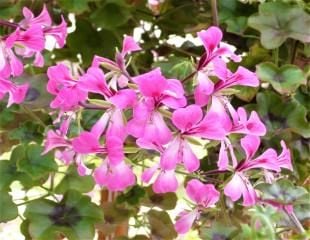
If you are looking for a drought resistant plant for a hanging basket, Pelargoniums are ideal. They will tolerate a good degree of drought and hot sunshine. I grow them all the year round in a conservatory which can get very hot in the summer, but they survive the high temperature and lack of attention well.
rosmarinus officinalis
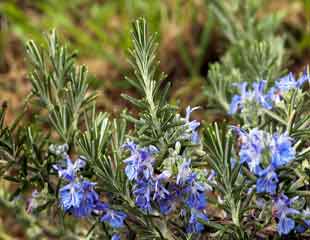
An excellent culinary herb, rosmarinus officinalis will tolerate dry soils if planted in a sheltered spot out of cold winds, with plenty of sun. Its leaves are aromatic and the shrub will reach around 2m although it can become woody with age. It has small blue flowers but if you constantly snip the tips (as I do) for cooking you may not see any flowers.
Eremurus
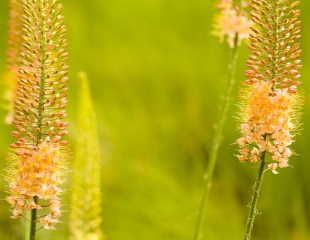
Also known as Fox tail Lily, this is a tall perennial reaching up to 1.5m and grown from tubers planted in autumn. They will flower best if planted in a sunny position and well drained/dry conditions are essential. Although described as fully hardy a mulch over the winter will help to protect the tubers. Eremurus will self seed.
Thymus
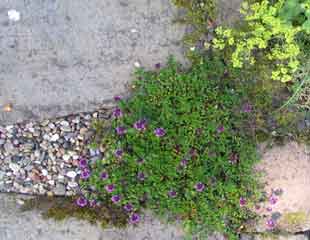
The herb Thymus will also grow in poor dry soils and is often to be found in cracks and crevices. There is a wide range of Thyme varieties available with attractive flowers which are much visited by bees. Thyme is a low growing mat forming hardy perennial, and it grows best in full sun. More about growing herbs.
Verbascum
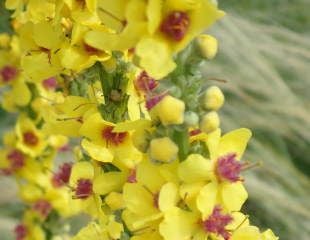
Verbascum is a perennial or biennial summer flowering plant tolerant of dry conditions. Verbascum will grow in poor dry soils and will not tolerate winter wet. All varieties have spikes of flowers some can be very tall up to 2m
Verbena bonariensis
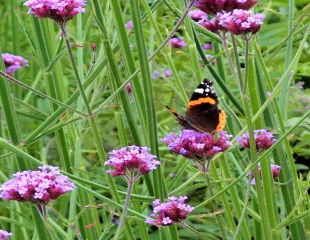
A good drought resistant perennial, it is also very attractive to pollinators and butterflies. It is a herbaceous perennial. Commonly grown is a tall variety up to around a metre, but you can also buy V. "Lollypop" a compact variety.
Salvia
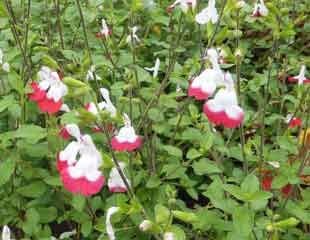
Salvia do well in hot dry conditions. The variety illustrated is 'Hot lips'. Some Salvia are borderline hardy and may not return reliably in wet soil which makes them a perfect plant for dry drought conditions.
updated 11.12.2023
